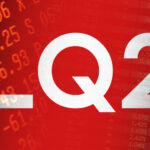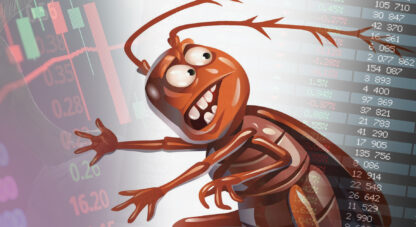The beginning of the year seems ages ago. Recall how securities markets fell under significant stress. Global central bankers responded (Pavlovian) with more QE and lower rates. Here at home, the Fed suspended its rate “normalization” plan after one single little baby-step. As for the Fed’s Q2 2016 “flow of funds” report, it was almost Like Old Times. Rapid GSE growth helped to liquefy U.S. securities markets, spurring speculative leveraging and Wall Street finance more generally, including securities firms balance sheets, “repos”, funding corps and, even, mortgage lending. Credit inflated, securities markets inflated, Household Net Worth inflated and the mirage of great wealth endured.
For the second quarter, Total Non-Financial Debt (NFD) expanded at a 4.4% rate, down from Q1’s 5.4% (while matching Q2 2015). Household debt growth jumped to a 4.4% pace (from Q1’s 2.7%), the strongest expansion in two years. Total Business (including financial) debt growth dropped to 4.1% from Q1’s 9.4% pace (and vs. Q2 2015’s 7.9%), the slowest expansion in 10 quarters (Q4 2013). State & Local borrowings expanded at a 2.2% rate, up from Q1’s 0.8% to the strongest rate since Q4 2010. Federal government borrowings slowed slightly from 5.6% to 5.0%, which was about double the growth from Q2 2015 (2.7%).
In seasonally-adjusted and annualized (SAAR) dollars, NFD expanded $1.999 TN, right at my theoretical bogey for Credit growth sufficient to sustain the U.S. Bubble. During Q2, Household debt expanded SAAR $622bn, surpassing Total Business ($540bn) for the first time since Q1 2011. State & Local borrowings expanded SAAR $66bn.
Leading the Credit charge – once again – was the federal government. Federal borrowing jumped SAAR $751bn, down from Q1’s $852 but still the strongest Q2 borrowings since 2012. Federal expenditures rose to a record SAAR $4.137 TN, up 41% compared to pre-crisis Q2 2007. At SAAR $3.470 TN, Q2 federal receipts were up 30% compared to Q2 2007. Deficits have this year been running at the fastest pace since 2012.
Also keeping quite occupied in Washington, GSE holdings jumped SAAR $348bn. This was up sharply from Q1’s $9.9bn growth and Q2 2015’s $70.9bn. GSE holdings enjoyed their strongest quarterly expansion since Q2 2008. The second quarter saw FHLB (Federal Home Loan Banks) Loans increase SAAR $168bn (up from Q1’s $51bn), the biggest quarterly growth since Q3 2008. (Worth noting from FHLB financial statements, Advances to Member Banks expanded almost 9% in the year’s first half to $690bn). Again, Like Old Times.
Total Agency- and GSE-backed Securities expanded SAAR $581bn (GSE debt $422bn and MBS $159bn) during Q2, up from Q1’s $60.4bn and Q2 2015’s $216bn. Here as well, Q2 saw the strongest expansion in GSE Securities since Q3 2008. For perspective, GSE Securities increased $293bn in (bond crisis) 1994, $474bn in (Russia/LTCM) 1998, $593bn in (Y2K) 1999, $642bn in (tech crash) 2001 and $547bn in (corporate Credit crisis) 2002. The big buyers of Agency securities during Q2? Money Market Mutual Funds increased GSE holdings by SAAR $403bn during the quarter. ROW snapped up SAAR $104bn.
Security Brokers/Dealer holdings expanded SAAR $301bn (strongest quarter since Q1 2012), up from Q1’s SAAR $195bn and Q2 2015’s SAAR $135bn contraction. Debt Security holdings rose SAAR $174bn and Repos surged SAAR $328bn. Miscellaneous Assets declined SAAR $250bn. On the Liability side, Repos rose SAAR $228bn and Misc. – Other increased SAAR $92bn.
Riding a nice GSE tailwind, securities finance enjoyed a banner quarter. Federal Funds and Security Repurchase Agreements increased SAAR $627bn, the biggest quarterly increase since Q1 2008. This reversed two quarters of Repo contraction, in what has been extraordinary quarter-to-quarter volatility. Funding Corps expanded SAAR $27bn during Q2, increasing one-year growth to $233bn, or 16.8%.
Corporate (and Foreign) Bond issuance slowed to $90.5bn during the quarter, down from Q1’s booming $494bn and Q2 2015’s $591bn. And while there may have been some temporary tightening of corporate Credit, the opposite was true elsewhere. Consumer Credit expanded SAAR $230bn, up from Q1’s SAAR $199bn and compared to Q2 2015’s SAAR $267bn. Trade Credit surged SAAR $250bn, up from Q1’s $53.1bn and Q2 2015’s SAAR $170bn.
Private Depository Institutions (banks) increased Debt Securities holdings SAAR $316bn, up from Q1’s $148bn and Q2 2015’s $142bn. Loans expanded SAAR $679bn, down from Q1’s $783bn and compared to Q2 2015’s $639bn. For comparison, Loans increased $261bn in 2013, $579bn in 2014 and $676bn in 2015. Notably, mortgage loans, held as bank assets, jumped SAAR $390bn during Q2, the strongest mortgage lending since Q3 2007 ($433bn).
Total Mortgage Debt expanded SAAR $521bn, the biggest mortgage debt increase since before the crisis (Q1 2008). Total Home Mortgage Debt increased SAAR $259bn (up from Q1’s $205bn and Q2 2015’s $215bn), matched by an almost equal amount of Multifamily and Commercial mortgage debt growth.
Rest of World (ROW) increased holdings of U.S. Financial Assets by a notable SAAR $1.193 TN during Q2, up from Q1’s $444bn to the highest level since Q1 2015. ROW Debt Securities holdings increased SAAR $417bn, led by a SAAR $324bn increase in U.S. Corporate Bonds. Foreign Direct Investment (FDI) jumped SAAR $606bn. Also noteworthy, ROW U.S. Liabilities jumped SAAR $1.061 TN, led by a SAAR $383bn increase in Repos. Like Old – 2006 and 2007 – Times.
Total Debt Securities (Fed’s compilation) ended Q2 at a record $40.581 TN, up a nominal $252bn for the quarter and $1.618 TN (4.2%) over four quarters. Total Debt Securities expanded $9.635 TN, or 31%, since the end of 2007. Over this period, Treasury Securities increased to $15.385 TN from $6.051 TN, for growth of 154%. The increase in Treasuries accounted for 84% of the growth of Total Debt Securities. Outstanding GSE Securities increased $926bn (13%) over this period to $8.324 TN. As such, the combined growth of “Washington finance” (Treasury & GSE) amounted to 92% of the Total Debt Securities expansion since the beginning of 2008.
Total Debt Securities ended Q2 at 220% of GDP. This compares to 200% to end 2007. Equities ended Q2 at $36.112 TN (down $1.415 TN y-o-y), or 196% of GDP. Equities peaked at $26.433 TN, or 181% of GDP, during Q3 2007.
Total (Debt and Equities) Securities ended Q2 at $76.693 TN, or 416% of GDP. Total Securities to GDP began the eighties at 117% ($3.086 TN) and the nineties at 193% ($10.937 TN). This ratio ended Bubble year 1999 at 360% ($34.753 TN) and Bubble year 2007 at 378% ($54.768 TN) – (peaked Q3 2007 at 379%).
The Household balance sheet remains fundamental to Bubble Analysis. Household Assets inflated $1.238 TN during Q2 to a record $103.750 TN, with both Real Estate ($25.6 TN) and Financial Assets ($72.3 TN) at record highs. Household Assets increased $3.053 TN (3.0%) y-o-y and were up $8.023 TN (8.4%) in two years. With Household Liabilities increasing $163bn during Q2, Household Net Worth jumped $1.075 TN during the period to a record $89.063 TN. Since the end of 2008, Household Net Worth has inflated $33.30 TN, or 60%. Household Net Worth had peaked previously at $67.744 TN during Q2 2007.
The ratio of Household Net Worth to GDP increased two percentage points to 483%. Net Worth to GDP peaked at 379% (1989) during the eighties Bubble; 435% (Q4 1999) during the “Tech” Bubble; and 473% (Q1 2007) during the mortgage finance Bubble period.
September 21 – Reuters (Leika Kihara and Stanley White): “The Bank of Japan made an abrupt shift on Wednesday to targeting interest rates on government bonds to achieve its elusive inflation target, after years of massive money printing failed to jolt the economy out of decades-long stagnation. While the BOJ reassured markets it would continue to buy large amounts of bonds and riskier assets, the policy reboot appeared to open the door for an eventual winding down of its huge asset purchases, and tried to repair some of the damage caused by its shock move to negative rates early this year. ‘The impression is that the BOJ is starting to pull back some of its troops from the battlefront,’ said Katsutoshi Inadome, senior fixed-income strategist at Mitsubishi UFJ Morgan Stanley Securities. The BOJ’s increasingly radical stimulus efforts are being closely watched by other global central banks which are also struggling to revive growth…”
It was another interesting week. No meaningful surprises from the Fed or the Bank of Japan (BOJ). A Bloomberg headline capture market sentiment: “Kuroda’s Journey From Shock-And-Awe to Bond Market Fine-Tuning.” The Fed again refrained from a second baby step, while forewarning the markets of a likely hike in December. Market participants chuckled as they bought stocks, risk assets and precious metals.
And it’s all been fun and games. Except for the harsh reality that QE hasn’t been working, and the markets know that policymakers know. Policymakers will never admit as much, but they’ve run short of options. Japan is an absolute policy debacle in the making. European bank problems continue to fester – in Italy, Germany and elsewhere. Here in the U.S., a potentially destabilizing election is now just about six weeks away. And let’s not forget the historic Chinese Credit Bubble that gets scarier by the week.
September 23 – CNBC (Katy Barnato): “Toxic loans in the Chinese financial system could be 10 times as high as official estimates suggest, Fitch Ratings has warned. The international ratings agency said in a report on Thursday that, as a proportion of China’s total loan pool, non-performing loans (NPLs) could be as high as 15-21 percent. By comparison, official data put the NPL ratio for commercial banks at 1.8%… ‘There seems a high likelihood that banks’ NPL ratios will continue rising over the medium term, in light of this discrepancy. There are already signs of stress, most obviously in the increased frequency with which banks are writing off or offloading loans, such as those to asset-management companies’… Solving China’s bad loan problem would result in a capital shortfall of 7.4 trillion-13.6 trillion yuan ($1.1-2.1 trillion), equivalent to around 11-20% of China’s economy, Fitch said.”
For the Week:
The S&P500 rallied 1.2% (up 5.9% y-t-d), and the Dow increased 0.8% (up 4.8%). The Utilities surged 3.4% (up 18.3%). The Banks gained 1.3% (down 2.5%), and the Broker/Dealers jumped 1.8% (down 2.4%). The Transports rose 2.1% (up 5.7%). The broader market was strong. The S&P 400 Midcaps rallied 2.0% (up 10.9%), and the small cap Russell 2000 surged 2.4% (up 10.5%). The Nasdaq100 increased 0.8% (up 5.8%), and the Morgan Stanley High Tech index added 0.7% (up 9.9%). The Semiconductors increased 0.4% (up 21.3%). The Biotechs jumped 2.6% (down 9.7%). With bullion jumping $31, the HUI gold index rallied 4.2% (up 1%).
Three-month Treasury bill rates ended the week at 17 bps. Two-year government yields declined a basis point to 0.75% (down 30bps y-t-d). Five-year T-note yields fell four bps to 1.16% (down 59bps). Ten-year Treasury yields declined seven bps to 1.62% (down 63bps). Long bond yields dropped 10 bps to 2.35% (down 67bps).
Greek 10-year yields dropped 22 bps to 8.23% (up 91bps y-t-d). Ten-year Portuguese yields declined four bps to 3.35% (up 83bps). Italian 10-year yields fell 13 bps to 1.21% (down 38bps). Spain’s 10-year yields dropped 11 bps to 0.96% (down 81bps). German bund yields declined eight bps to negative 0.08% (down 70bps). French yields fell nine bps to 0.21% (down 78bps). The French to German 10-year bond spread narrowed one to 29 bps. U.K. 10-year gilt yields dropped 14 bps to 0.73% (down 123bps). U.K.’s FTSE equities index jumped 3.0% (up 10.7%).
Japan’s Nikkei 225 equities index increased 1.4% (down 12% y-t-d). Japanese 10-year “JGB” yields were unchanged at negative 0.05% (down 31bps y-t-d). The German DAX equities index surged 3.4% (down 1.1%). Spain’s IBEX 35 equities index rose 2.2% (down 7.6%). Italy’s FTSE MIB index recovered 1.6% (down 23.2%). EM equities were higher. Brazil’s Bovespa index jumped 2.9% (up 35.4%). Mexico’s Bolsa surged 4.0% (up 11.2%). South Korea’s Kospi rallied 2.7% (up 4.7%). India’s Sensex equities added 0.2% (up 9.8%). China’s Shanghai Exchange gained 1.0% (down 14.3%). Turkey’s Borsa Istanbul National 100 index surged 4.9% (up 11.2%). Russia’s MICEX equities index gained 1.5% (up 14.2%).
Junk bond mutual funds saw outflows of $274 million (from Lipper).
Freddie Mac 30-year fixed mortgage rates dipped two bps to 3.48% (down 38bps y-o-y). Fifteen-year rates slipped a basis point to 2.76% (down 32bps). Bankrate’s survey of jumbo mortgage borrowing costs had 30-yr fixed rates up a basis point to 3.63% (down 26bps).
Federal Reserve Credit last week expanded $2.9bn to $4.426 TN. Over the past year, Fed Credit declined $30.4bn. Fed Credit inflated $1.615 TN, or 57%, over the past 202 weeks. Elsewhere, Fed holdings for foreign owners of Treasury, Agency Debt dropped $14.3bn last week to a new two-year low $3.150 TN. “Custody holdings” were down $201bn y-o-y, or 6.0%.
M2 (narrow) “money” supply last week surged another $37.4bn to a record $13.077 TN. “Narrow money” expanded $885bn, or 7.3%, over the past year. For the week, Currency increased $2.5bn. Total Checkable Deposits jumped $39bn, while Savings Deposits declined $4.5bn. Small Time Deposits added $0.9bn. Retail Money Funds were little changed.
Total money market fund assets rose $10.7bn to $2.670 TN. Money Funds increased $10bn y-o-y (0.4%).
Total Commercial Paper dropped another $21.1bn to a multi-year low $942.6bn. CP declined $88bn y-o-y, or 8.5%.
Currency Watch:
September 19 – Bloomberg: “China’s desire to stabilize the yuan risks undermining its future as a global reserve currency. For the second time this year, the overnight cost to borrow the offshore currency in Hong Kong surged above 20% amid speculation the People’s Bank of China is mopping up liquidity to boost the exchange rate. The volatility comes less than two weeks before the yuan’s inclusion in the International Monetary Fund’s Special Drawing Rights — an event seen as a validation of President Xi Jinping’s efforts to promote its standing on the world stage.”
The U.S. dollar index declined 0.6% to 95.51 (down 3.2% y-t-d). For the week on the upside, the South African rand increased 3.3%, the Norwegian krone 2.4%, the Australian dollar 1.8%, the Japanese yen 1.2%, the Swiss franc 1.0%, the euro 0.6%, the Brazilian real 0.6%, the Swedish krona 0.3%, Canadian dollar 0.3% and the New Zealand dollar 0.3%. For the week on the downside, the Mexican peso declined 0.9% and the British pound slipped another 0.3%. The Chinese yuan was little changed versus the dollar (down 2.7% y-t-d).
Commodities Watch:
The Goldman Sachs Commodities Index gained 1.0% (up 12.8% y-t-d). Spot Gold jumped 2.4% to $1,342 (up 26%). Silver surged 5.0% to $19.78 (up 43%). Volatile Crude recovered $1.45 to $44.48 (up 20%). Gasoline gave back 5.8% (up 8%), while Natural Gas added 0.3% (up 27%). Copper jumped 1.9% (up 3%). Wheat increased 0.4% (down 14%). Corn was little changed (down 6%).
China Bubble Watch:
September 22 – Bloomberg (Kyoungwha Kim): “A spike in yuan borrowing costs offshore is spreading to mainland China, with rates in Shanghai climbing to seven-month highs amid speculation policy makers are looking to reduce leverage and keep the currency steady. The one-day Shanghai Interbank Offered Rate rose to 2.17% on Thursday, the highest since Feb. 6… The comparable cost in Hong Kong surged to 23.7% on Monday, the highest since suspected central bank meddling roiled global markets in January.”
September 22 – Bloomberg (Yashaswini Swamynathan): “The lines between China’s financial sector and property market are getting blurrier still. While the degree to which China’s banking system is exposed to its red-hot real estate sector has long concerned analysts, a new report from CreditSights Inc. suggests a fresh link is growing. Chinese property developers such as Greenland Hong Kong Holdings Ltd., Country Garden Holdings Co., and China Evergrande Group have been bulking up their online finance businesses, offering loans and other financial products to retail investors as a way to drive revenue, diversify their business, or repay debt. ‘Internet finance has become a new growth area for Chinese developers, to our surprise and concern,’ the analysts wrote… ‘The deviation from the core real estate business and the opaque nature of internet finance worry us.’”
September 19 – Wall Street Journal (Jacky Wong): “China’s attempts to contain property prices have been halfhearted. If anything, they may have made the bubble grow even bigger. Average new-home prices in August were up 1.3% from July, …the 17th straight increase and the biggest since at least January 2011…. The latest leg of China’s property boom, which began last year in the biggest cities—such as Shenzhen and Shanghai—has recently spread to smaller cities, driving local governments to roll out tightening measures.”
September 18 – Bloomberg: “Chinese home prices rose the most in more than six years last month, suggesting local government efforts to avert a housing bubble are having only a limited effect. New-home prices… in August gained in 64 of the 70 cities the government tracks, compared with 51 in July… Average new-home prices in the 70 cities rose 1.2% in August from July, the biggest increase since January 2010… The value of home sales jumped 33% last month from a year earlier, the fastest pace in four months.”
September 21 – Reuters (Yawen Chen and Nathaniel Taplin): “China’s listed property developers issued 960 billion yuan (110.8bn pounds) in bonds as of Sept. 19, more than three times the amount in the same period last year, financial magazine Caixin reported… At this pace, there is no suspense that bond sales by property developers would reach over 1 trillion yuan ($149.91bn) this year,’ the report said… Average new home prices in China climbed 9.2% in August from a year earlier, up from 7.9% in July as buyers piled into the market…”
September 19 – Bloomberg: “China’s shadow banking could lead to losses of $375 billion, according to CLSA Ltd. Estimates… The brokerage estimated the potential bad debt ratio for ‘bank-related shadow financing’ at 16.4%, or 4.2 trillion yuan, in a report… Assuming a 40% recovery rate left a potential loss of 2.5 trillion yuan. ‘Shadow financing is banking reform gone wrong given that the key driver of growth has been the banks circumventing regulations to protect their margins,’ analyst Francis Cheung wrote… ‘Shadow financing has grown rapidly, benefiting from implicit government guarantees despite being a channel for credit to higher-risk industries.’”
September 23 – Bloomberg: “China’s approval of credit-default swap trading for the first time is fueling speculation authorities will allow more bond delinquencies as the economy slows. The People’s Bank of China has approved rules governing CDS trading in the nation’s interbank market, according to a statement from the National Association of Financial Market Institutional Investors, a unit under the central bank. The purpose is to help diversify credit risks and facilitate healthy development of the market, the statement said.”
Europe Watch:
September 23 – Bloomberg (Tom Beardsworth): “Junior bonds of Banca Monte dei Paschi di Siena SpA fell to an eight-month low after a media report said the troubled Italian bank may require state support. Monte Paschi’s 379 million euros ($424 million) of 5.6% notes due in September 2020 fell 1.6 cents on the euro to 62.6 cents, the lowest since Jan. 21…The worst-performing lender in euro-area stress tests this year may have to turn to the government as it struggles to raise 5 billion euros in capital…”
September 22 – Reuters (John O’Donnell): “European regulators expect Italian bank Monte dei Paschi di Siena will have to turn to the government for support, three euro zone officials with knowledge of the matter said, although Rome would strongly resist such a move if bondholders suffered losses. Less than two months after the Tuscan lender announced an emergency plan to raise 5 billion euros of fresh capital, having come last in a health check of 51 European banks, there is growing concern among European regulators that the cash bid will fall short.”
September 22 – Bloomberg (Boris Groendahl): “The euro area’s biggest banks will be asked to earmark funds equivalent to more than twice their minimum capital requirements to make sure a possible emergency doesn’t cost taxpayers, according to Elke Koenig, head of the Single Resolution Board. The Brussels-based SRB, the resolution authority for 142 banks including Deutsche Bank AG and BNP Paribas SA, will use the minimum capital requirement set by the European Central Bank as a proxy for funds that would be needed to absorb losses and allow recapitalization in a crisis… The European Banking Authority said in July that the region’s banks may need as much as 470 billion euros ($524bn) in additional MREL-eligible funding under conditions similar to those cited by Koenig.”
September 23 – Bloomberg (Matt Clinch): “There was more bad news for euro zone on Friday with the latest flash purchasing manager’s index (PMI) falling to a near two-year low, indicating that the economic upturn in the region is fragile and failing to achieve any real traction. The preliminary PMI from Markit showed that business activity in the 19-country region fell to 52.6 in September versus 52.9 in August and below market expectations.”
September 18 – Reuters (Gavin Jones): “Italian Prime Minister Matteo Renzi stepped up his attacks against other European Union leaders on Sunday after an EU summit in Bratislava which he said amounted to no more than ‘a nice cruise on the Danube.’ In a fiery interview… Renzi – who has staked his career on a referendum this year on his plan for constitutional reform – intensified his criticisms… ‘If we want to pass the afternoon writing documents without any soul or any horizon they can do it on their own,’ Renzi said… ‘I don’t know what Merkel is referring to when she talks about the ‘spirit of Bratislava’… If things go on like this, instead of the spirit of Bratislava we’ll be talking about the ghost of Europe.’”
Brexit Watch:
September 22 – Bloomberg (Gavin Finch and John Detrixhe): “Executives at global investment banks in London expect France and Germany will prevail in a tussle over the clearing of $570 billion of euro derivatives and are making plans to deal with the fallout, according to people at four of the biggest firms. They assume the City of London will eventually be stripped of the ability to clear euro denominated swaps after Britain formally exits the European Union… While that might take years to happen, employees and operations central to the clearing function will be among the first moved to the continent once Brexit is triggered…”
Fixed-Income Bubble Watch:
September 18 – Financial Times (Eric Platt): “Global bond issuance is running at its fastest pace in nearly a decade as companies, countries and US agencies such as Fannie Mae and Freddie Mac binge on debt in an era of historically low interest rates. A total of $4.88tn of debt has been sold since the year began… according to… Dealogic. The figure is a hair below that of 2007, when $4.91tn of bonds were issued during the same period… Debt sales this year are running 9% ahead of the pace in 2006, when banks underwrote a record $6.6tn of debt. The figures do not include sovereign bonds sold at auction… ‘The leverage increase is significant,’ said Rick Rieder, BlackRock’s fixed income chief investment officer. ‘There is a long discussion about if this is a shift in the credit cycle. It’s something we’ve never seen before.’”
September 20 – Bloomberg (Claire Boston and Harvard Zhang): “Investors are cooling on one of the hottest U.S. corporate bond trades this year. Corporate bonds maturing in 10 years or more have fallen 2.9% in September…, a drop that is nearly five times as large as the broader bond market’s decline and that erases some of the double-digit gains of the previous eight months… Even with recent declines, long-dated bonds are still up more than 14% for 2016 through Monday’s close, including price gains and interest payments.”
September 20 – Bloomberg (Tracy Alloway): “Would you like to supersize that corporate bond sale? Companies selling their debt to eager investors have replied with a collective ‘yes.’ They’ve opted to increase their issuance of mega-sized bonds of $5 billion or more to a record $330 billion in 2015, according to data from HSBC Holdings Plc.”
Global Bubble Watch:
September 22 – Reuters (Yashaswini Swamynathan): “U.S. stocks marched higher on Thursday, with the Nasdaq hitting a record intraday high, as investors cheered the Federal Reserve’s decision to not raise interest rates. While the Fed said the risks to economic outlook were roughly ‘balanced’, it left rates unchanged for want of ‘further evidence of continued progress’. Inflation remains below the central bank’s target of 2% and members saw room for improvement in the labor market. The Fed also slowed the pace of future hikes and cut its longer run interest rate forecast, but sent a strong signal for a rate hike by the end of this year.”
September 20 – Bloomberg (Tom Beardsworth): “Deutsche Bank AG’s riskiest bonds dropped to the lowest since a marketwide rout in February as a potential $14 billion bill to settle a U.S. probe into mortgage-backed securities reignited capital concerns. The lender’s 1.75 billion euros ($2bn) of 6% additional Tier 1 bonds, the first notes to take losses in a crisis, fell four cents on the euro to 72 cents… That extended the decline since the U.S. Department of Justice’s initial settlement figure was announced last week to 11 cents.”
September 19 – Financial Times (Henny Sender): “Mid-Autumn Festival, which honours the full moon and is supposed to bring peace and prosperity in China, is a time for reflection. It is also a time for normally non-reflective types such as hedge fund managers to tally up their gains and losses as the final quarter of the year approaches. ‘The biggest mistake many made,’ says one Singapore-based investor, ‘was to believe the Fed would raise rates four times and all go long the dollar. That was the pain trade of this year.’ In fact, contrary to those who naively took the Fed at its word, liquidity continued to drive financial markets, saving those that seemed near death not long ago. Thus Glencore, the object of many short bets on the belief that it would prove insolvent less than a year ago, was able to borrow for virtually nothing, despite its less than stellar rating. Similarly, faith that Vedanta, an Indian commodities and energy group, would not go bust helped the bottom line of many distressed players.”
September 22 – Bloomberg: “The explosive growth of spending overseas by Chinese tourists dwarfs the increase in the number of Chinese traveling abroad. The most likely reason? Disguised capital outflows. So says former U.S. Treasury official Brad Setser, who drilled into the spending data provided by some of the most popular destinations for Chinese travelers. The nation’s tourism deficit — a measure of foreign visitor expenditure in China minus what its citizens spend overseas — soared to $206 billion in the 12 months through June 30, up from $77 billion in 2013…”
September 20 – Wall Street Journal (Jon Sindreu): “In their efforts to stimulate economies, central banks have been swelling government coffers. Last year, the central banks of eight large developed economies remitted about $149 billion to their respective governments, more than triple the $40 billion they sent along in 2005…”
September 19 – Bloomberg (Katya Kazakina): “Art dealer and collector Niels Kantor paid $100,000 two years ago for an abstract canvas by Hugh Scott-Douglas with the idea of quickly reselling it for a tidy profit. Instead, he is returning the 28-year-old artist’s work to the market this week at an 80% discount. Such is the new art season. At auction houses in London and New York, sellers are preparing to bail on their investments after the emerging-art bubble burst and the resale market for once sought-after artists dried up. ‘I’d rather take a loss,’ said Kantor… ‘I feel like it can go to zero. It’s like a stock that crashed.’”
September 19 – Wall Street Journal (Bob Tita): “Used machinery is flooding the secondhand market, piling more pain on equipment makers battling slack demand from any customer that mines, moves or refines commodities amid a global slump in the value of everything from coal to corn. Instead of buying a new $500,000 bulldozer or $300,000 excavator, many construction firms and other equipment users are renting or entering longer-term leases for machines to expand their fleets or replace worn out equipment, dealers and analysts say. Dealers, in turn, are keeping smaller inventories of new wheel loaders, backhoes and other machinery.”
U.S. Bubble Watch:
September 22 – Bloomberg (Yashaswini Swamynathan): “Sales of previously owned U.S. homes unexpectedly declined to a six-month low in August, signaling buyers are getting discouraged by a limited selection of properties that’s kept prices high… Sales rose 7.3% from August 2015… Median price of an existing home increased 5.1% from August 2015 to $240,200. Inventory of available properties fell 10.1% from a year earlier to 2.04 million.”
September 20 – Bloomberg (Sho Chandra): “New U.S. home construction fell more than projected in August as a plunge in the South, the biggest region for building, more than offset gains in the rest of the country. Residential starts declined 5.8% to a 1.14 million annualized rate, from the prior month’s revised 1.21 million pace…”
September 22 – Wall Street Journal (Maureen Farrell): “The battered IPO market and a flood of cheap funding for companies have cut so deeply into the business of selling stocks that some on Wall Street worry the pillar of investment banking may never fully recover. U.S. equity-capital-markets revenue for banks is lower than it has been in more than 20 years, according to Dealogic. So far this year, banks have taken in just $3.7 billion in fees from U.S.-listed equity deals…”
Federal Reserve Watch:
September 22 – Wall Street Journal (Jon Hilsenrath and David Harrison): “The Federal Reserve left short-term interest rates unchanged Wednesday but signaled it still expected to raise them before year-end, reaching a temporary truce among officials divided over when to withdraw financial stimulus from the economy. Fed Chairwoman Janet Yellen offered an upbeat assessment of the economic outlook, noting that growth has picked up after a dismal first half, with household incomes growing solidly and workers rejoining the labor force in search of jobs after years of not looking.”
September 22 – Financial Times (Robin Wigglesworth and Joe Rennison): “Washington’s ‘Mighty Doves’ once again vanquished the ‘Regional Hawks’ at this week’s monetary policy fixture, with the Federal Reserve electing to keep interest rates on hold spurring a rally across equities, bonds and emerging market assets. Three regional Fed heads voted to raise rates while the central bank’s customarily more dovish board members voted to stay on hold. This is only the fifth case of a three-vote dissent in 30 years but fund managers say ‘lower for longer’ remains the leitmotif for financial markets.”
September 21 – Bloomberg (Anchalee Worrachate and Chikako Mogi): “The dollar fell against most of its major peers, extending a slide toward its biggest annual decline in seven years, after the Federal Reserve delayed raising interest rates.”
Central Bank Watch:
September 23 – Reuters (Balazs Koranyi): “European Central Bank interest rates are probably close to the bottom, even though the bank had hoped the euro zone economy would respond better to its stimulus measures, two top policymakers said on Friday. With ECB rates now well into negative territory, the potential for detrimental side effects are increasing as they cut into banking profitability and raise the risk of asset bubbles and market distortions, the policymakers said.”
September 21 – Financial Times (Claire Jones): “Officials at the European Central Bank fear they could be hemmed in by legal action as they look for ways to extend their quantitative easing programme to help fuel the eurozone’s fragile recovery. The €80bn-a-month bond buying plan is already the subject of a legal challenge and officials fear that its problems in court will increase if the ECB relaxes the conditions of the scheme — a move staff are considering. Peter Gauweiler, a conservative German politician who has sued the ECB in the past, told the Financial Times that changes to QE would ‘increase the chances of success’ of a case he and others are trying to bring against the asset purchase programme… Mr Gauweiler believes that QE ‘already violates rules on the prohibition of monetary financing [of eurozone governments] by the ECB’ — even before any alteration of its conditions. He said that softening the rules could redistribute the risk of a member state default, ‘which is clearly incompatible with European law’.”
September 18 – Reuters (Paul Carrel): “The European Central Bank suffers from a conflict of interests due to its dual responsibilities for setting monetary policy in the euro zone and for supervising banks, ECB policymaker Jens Weidmann said. ‘As a banking supervisor, it could find it difficult to be tough with a bank or even wind it down if it knows that, because of its monetary policy measures, it is its biggest creditor,’ Weidmann told Germany’s Sueddeutsche Zeitung…”
Japan Watch:
September 21 – Bloomberg (Toru Fujioka): “The Bank of Japan shifted the focus of its monetary stimulus Wednesday from expanding the money supply to controlling interest rates, which some economists deemed as further evidence that BOJ policy had reached the limits of its effectiveness. The central bank said it would adjust the volume of its asset purchases, the core of its framework until now, as necessary in the short term to control bond yields, while keeping it at about 80 trillion yen ($780bn) annually over the long term. The BOJ also scrapped a target for the average maturity of its holdings of government bonds.”
September 21 – Bloomberg (Enda Curran and Toru Fujioka): “Bank of Japan Governor Haruhiko Kuroda stormed onto the global stage back in 2013 with the subtlety of a Metallica concert, electrifying markets with a shock-and-awe monetary expansion powered by increased purchases of Japanese government bonds. On Wednesday, Kuroda seemed a little bit more like a jazz musician, riffing variations on established themes. It’s not the sort of stuff that quickens the hearts of investors. The BOJ refrained from another interest rate cut and instead pledged to bolster the long-end of the bond market’s yield curve. It’s a move that will help Japanese banks, pension funds and insurers cope in a less-than-zero rate environment, but disappointing to economists who had hoped for more dramatic action.”
September 20 – Bloomberg (Connor Cislo): “Japan’s poor exports performance continued in August, with shipments falling for an 11th straight month as a strong yen and tepid global economy undercut demand. Exports dropped 9.6% in August from a year earlier…”
EM Watch:
September 18 – Bloomberg (Lyubov Pronina): “Emerging-market issuers are exposing themselves to greater currency volatility by letting dollar borrowings outstrip their buffer of reserves, according to the Bank for International Settlements. Developing-nation companies including state-owned enterprises have accumulated $3.2 trillion of dollar debt… ‘In many cases, rising foreign currency debt has not been matched with FX assets and revenues,’ according to the report by the BIS, which acts as a global forum for as many as 60 central banks. ‘There is a great risk that booms and busts in capital flows will cause large shifts in exchange rates.’”
September 23 – CNBC (Isobel Finkel and Benjamin Harvey): “Turkey’s sovereign credit rating was cut to junk by Moody’s…, which concluded a review initiated after an unsuccessful coup attempt on July 15. Moody’s cited rising risks related to Turkey’s external financing needs and a weakening in credit fundamentals as economic growth slows… ‘The risk of a sudden, disruptive reversal in foreign capital flows, a more rapid fall in reserves and, in a worst-case scenario, a balance of payments crisis has increased,’ Moody’s said…”
September 22 – Bloomberg (John Micklethwait and Sangwon Yoon): “Turkey’s President Recep Tayyip Erdogan said he is not worried if his country is rated below investment grade as credit rating firms are making wrong decisions because of their political bias. ‘I don’t care at all, they’re making mistakes and they’re doing it intentionally,’ Erdogan said in an interview in New York… ‘Whether you’re honest or not, Turkey’s economy is strong.’”
Brazil Watch:
September 22 – Bloomberg (Sabrina Valle and Mario Sergio Lima): “Brazil’s former Finance Minister Guido Mantega was released a few hours after being arrested on Thursday in connection to the so-called Carwash corruption probe that has shaken the nation’s business and political elite… Mantega, Brazil’s longest-serving finance minister, was arrested based on testimony and banking documents from Brazilian former billionaire Eike Batista… Mantega had requested a payment of 5 million reais, worth $2.35 million at the time, to a political marketing company linked to the ruling Workers’ Party…”
Leveraged Speculator Watch:
September 21 – CNBC (Joe Marino): “Billionaire Leon Cooperman and his Omega Advisors hedge fund were charged Wednesday with insider trading, the Securities and Exchange Commission announced. The SEC accused Cooperman of buying into Atlas Pipeline Partners ahead of a deal, using his status as one of its largest shareholders to acquire nonpublic information about an upcoming transaction. ‘We allege that hedge fund manager Cooperman, who as a large APL shareholder obtained access to confidential corporate information, abused that access by trading on this information,’ said Andrew J. Ceresney, director of the SEC’s Division of Enforcement. ‘By doing so, he allegedly undermined the public confidence in the securities markets and took advantage of other investors who did not have this information.’”
September 22 – Bloomberg (Dani Burger): “For once, the trend was nobody’s friend. Commodity trading advisers, the catch-all phrase for a breed of quantitative investors who use trends in asset prices and volatility as trading signals, posted some of the hedge fund industry’s worst losses in August — and it isn’t getting better. The group is down between 1% to 1.5% this month, according to Credit Suisse… Wrong-way bets on everything from Treasury rates to commodities have cost trend followers as market correlation whipped up before this week’s meeting of the Federal Reserve. In particular, CTAs paid a price for betting interest rates would fall in the second half of the year, Credit Suisse said. ‘The trend-following CTAs have given back the vast majority of a profitable first half of 2016 as their long equities, long rates and short crude gambit results in losses,’ wrote Mark Connors, Credit Suisse’s global head of risk advisory in New York…”
Geopolitical Watch:
September 18 – Reuters (Paul Carrel and Michael Nienaber): “Chancellor Angela Merkel’s conservatives suffered their second electoral blow in two weeks on Sunday, with support for her Christian Democrats (CDU) plunging to a post-reunification low in a Berlin state vote due to unease with her migrant policy. The anti-immigrant Alternative for Germany (AfD) polled 11.5%, gaining from a popular backlash… The result means the AfD will enter a 10th state assembly, out of 16 in total. Merkel’s CDU polled 18%, down from 23.3% at the last election in 2011…”
September 23 – Bloomberg (Andre Tartar): “Syria’s civil war. North Korean nuclear tests. Brexit. Turkey’s failed coup. A volatile U.S. election. This jarring backdrop was hard to miss as world leaders stepped up to the familiar green marble dais during this week’s United Nations General Assembly. Heads of state and government representing the world’s largest economies used words like ‘fear,’ ‘uncertainty,’ ‘risk,’ and ‘terror’ 87 percent more often on average than during last year’s gathering, according to an analysis by Adam Tiouririne, a leadership communication adviser at Logos Consulting Group.”















